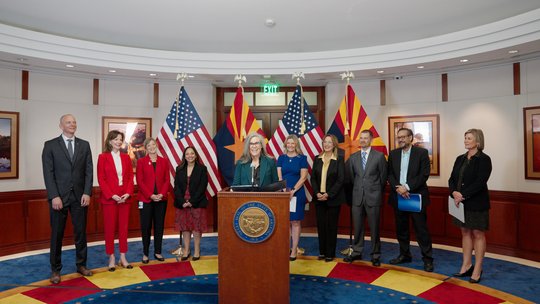
Standing before reporters at the Arizona State Capitol last month, Gov. Katie Hobbs announced a robust set of actions aimed at strengthening the state’s already highly-ranked semiconductor workforce.
The initiatives include a first-of-its-kind Registered Apprenticeship Program and a new, state-of-the-art training facility.
“These programs will bolster our already robust semiconductor talent pipeline and allow Arizonans to receive practical training in this growing, high-paying industry,” Hobbs said.
Joining the governor were representatives from some of Arizona’s most advanced semiconductor companies, economic development and workforce leaders, and childcare advocates, demonstrating the state’s collaborative approach to workforce development.
“All over the world, industry and government are talking about the need to train additional advanced manufacturing talent,” said Sandra Watson, president and CEO of the Arizona Commerce Authority. “In Arizona, we’re doing more than talking – we’re taking action.”
Arizona’s Registered Apprenticeship Program for semiconductors represents a partnership between state agencies and NXP, an advanced semiconductor manufacturer that operates two fabs in Chandler, Arizona. The company’s program will start with the industrial manufacturing technician occupation and explore additional occupations in the future. As part of its commitment, NXP will provide on-the-job learning and cover apprentice tuition costs.
At the event, NXP touted the program’s importance to help workers unfamiliar with semiconductors get started in the industry.
“For many Arizonans, this program represents an opportunity to learn new skills and apply their talents to be part of something bigger,” said Jason Conrad, senior director of operations at NXP’s ECHO Fab in Chandler.
With this model, state leaders plan to expand the program to additional companies and workers.
The Arizona Commerce Authority is investing $4 million to support apprentices on their journey, covering costs like books, materials, supplies, and wraparound support services such as transportation and child care. The investment will be matched by increased capacity at the Arizona Department of Economic Security’s Arizona Apprenticeship Office, which will add additional staff to enhance processing and program management.
The ACA also will establish an Employer Collaborative, leveraging its semiconductor task force to promote the use and development of apprenticeship programs to additional semiconductor leaders with a presence in the state.
“We’ve been meeting with representatives from industry, academia, workforce groups and more to better understand their needs and advance solutions to meet the rising demand for semiconductor talent,” said Watson. “Their contributions have strongly influenced this workforce action plan.”
Another key component of that plan involves the launch of the Maricopa Future48 Workforce Accelerator, a collaboration with Maricopa Community Colleges to scale semiconductor talent quickly. The new facility represents the third of six Future48 Workforce Accelerators established in the state, with the other two launching in Yuma in coordination with Arizona Western College and Kingman in partnership with Mohave Community College.
Major investments happening
In addition to leveraging the state’s wide network of community colleges, Arizona is investing significantly in its world-class research universities to advance workforce training and research and development.
In July, Arizona State University, Applied Materials Inc., and the ACA, announced the development of a $270 million Materials-to-Fab Center at ASU Research Park. The partnership will create a shared research, development, and prototyping facility to advance semiconductor innovation.
“Applied envisions the center at ASU playing a key role in accelerating materials engineering innovations, commercializing academic research and strengthening the pipeline of future semiconductor industry talent,” said Gary Dickerson, Applied Materials president and CEO.
Following that announcement, Hobbs, the ACA, and the University of Arizona announced a $35.5 million investment in the university’s Micro/Nano Fabrication Center (MNFC), a cleanroom facility that supports manufacturing and research efforts surrounding semiconductors, computer chips, optical devices, and quantum computing systems.
The funding will also support the expansion of training and educational modules, including $3 million committed to Pima Community College and Central Arizona College.
The investment from the ACA is part of a $100 million commitment announced last year to increase semiconductor and microelectronics development in the state.
These actions and more will help Arizona maintain its top spot as North America’s go-to destination for semiconductor investment, with more than $62 billion announced since 2020 and more than 30 industry expansions since 2021.
They also point to a thriving ecosystem bolstered by industry investment, cutting-edge research, prominent startups, and first-of-its-kind training programs.
With more investments on the horizon, Arizona promises to play a central role in the nation’s semiconductor renaissance.
To learn more about Arizona’s key semiconductor actions and advantages, visit azcommerce.com.


